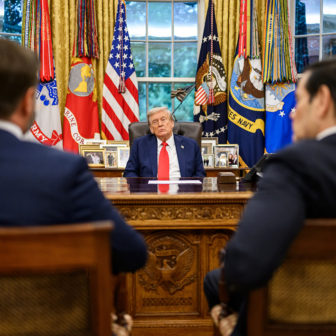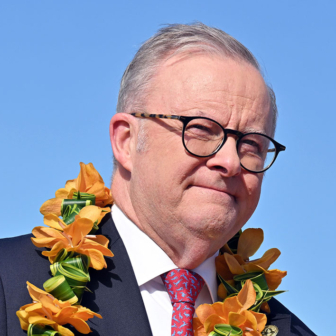At the annual Shangri La security dialogue in Singapore two weeks ago, US defense secretary Pete Hegseth didn’t just ask Australia to spend more on defence. He also unveiled plans for a new US military project here.
The intriguing thing about Hegseth’s announcement that the US was establishing an Indo-Pacific regional hub in Australia for repairing and maintaining the radar systems on P8 Poseidon maritime patrol aircraft for all allied users — the first such hub outside the continental United States — is that it only came from him. There was no parallel announcement from the country that will host the endeavour, Australia.
In his 1 June speech to the Singapore gathering, Hegseth also spoke about the US Army’s plans to conduct the first live-fire test of its mid-range capability system in Australia, also the first such test to be conducted “on foreign soil.” He further confirmed the two countries had recently finalised a foreshadowed agreement for Australia to produce ammunition and assemble guided multiple launch rocket systems.
“Deployments like this represent a commitment to the region and there are many more planned,” he assured the audience.
As the Pentagon embarks on a snap thirty-day review of the AUKUS submarine agreement to ensure it aligns with Donald Trump’s “America First” agenda, it’s worth noting that the security relationship between Australia and the United States cuts both ways. Much as the government doesn’t like to talk a lot about it, Australia is giving plenty under the deal as well as getting.
While AUKUS aims to deliver nuclear-powered submarines to Australia decades from now, it is delivering materially to the United States much sooner — not least and not only in the form of the $3 billion extra Australia is paying to help grease the wheels of US submarine production.
Of course, there are plenty of analysts who are scathing of the whole AUKUS agreement and lining up to warn that Australia may never get the boats at all, even without the implied threat of the review. Equally, there’s a growing chorus in the security community arguing that Australia is very underdone on defence spending and, whether on advisement or by its own deduction due to the geo-strategic environment, should increase it.
Gradually over recent years — and especially since the AUKUS deal was struck in 2021 between the governments of Scott Morrison, Boris Johnston and Joe Biden — the United States has steadily increased its military presence in Australia. Defence minister and deputy prime minister Richard Marles acknowledged this fact at his first meeting with Hegseth in Washington in February, describing AUKUS as “a very significant increase of the American footprint on the Australian continent.”
Australia has quietly become an increasingly crucial staging post for US and other forces in the event of military conflict in the Indo-Pacific. The current acceleration of that process, acknowledged in the Pentagon’s summary of the private talks between Hegseth and Marles on the Shangri-La sidelines, reflects Washington’s concern that such circumstances may be coming soon.
Successive Australian governments haven’t exactly banged the drum about it but quite a lot has been going on to prepare for such events. The number of US Marines rotating through Darwin has increased and the United States has built a huge fuel storage facility there, albeit not without some legal and logistical hiccups.
US military intelligence officers are embedding within the Australian Defence Intelligence Organisation. The US army now pre-positions equipment and stores at the Bandiana military base outside Albury–Wodonga and is building a permanent logistics support site in Queensland.
The two countries are jointly upgrading the Royal Australian Air Force bases in Darwin and Tindal, in the Northern Territory, and scoping similar upgrades at Curtin, Learmonth and Scherger in Western Australia. In conjunction with increasing joint military activities, the federal government is also upgrading the runway and other infrastructure on the Cocos (Keeling) islands in the Indian Ocean.
And US Virginia class submarines will soon be operating on rotation out of Western Australia, ostensibly training crew and transferring industrial servicing know-how under the AUKUS agreement. This also means the United States will have submarines available on this side of the Pacific, close to any action should it occur in the vicinity of, say, the Taiwan Straits.
Action or no, the AUKUS objective is to develop Australia’s capacity to maintain and sustain those US submarines in Western Australia long before Australia gets any subs of its own.
All of this is by way of saying that AUKUS isn’t just about Australia buying submarines. It is about Australia becoming an increasingly integrated part of the US military industrial and warfighting machine in this region.
This is the context for the political standoff between the Australian and US governments over levels of defence spending and America’s pressure for Australia to dramatically increase its current level of spending from around 2 per cent of GDP, and beyond its foreshadowed level of 2.3 per cent, to 3.5 per cent. On the one hand, Australia is facilitating increased access for and collaboration with the United States and Australia’s AUKUS submarine maintenance capability, once established, is supposed to help take pressure off US systems at home. On the other, the US administration wants Australia to spend and do a lot more.
Anthony Albanese’s response to the US edict has been logical on the face of it: that Australia will determine its own military spending based on its needs and the geostrategic circumstances rather than responding to a numerical edict from Washington. The politically tricky dimension is that in Washington and elsewhere, those GDP percentages are often seen as a reflection of political will.
On the same day this week that the Pentagon revealed its AUKUS review, spearheaded by defence under-secretary and unabashed AUKUS sceptic Elbridge Colby, Pete Hegseth appeared before a US Senate budget committee with a message for countries deemed not to be pulling their military weight. “You are our allies and our friends and we will stand with you,” Hegseth said. “But you need to stand up in times of peace and in times of war.”
Reflecting on his time in Afghanistan, the former National Guardsman praised those he served alongside, including Australians. But his story had a punchline, with the emphasis on punch. “We also wore a patch on our shoulder that said ‘ISAF’ — International Security Assistance Force,” he recounted. “And you know what the joke was? That it stood for ‘I Saw Americans Fight’.”
There were, he said, “a lot of flags, not a lot of on-the-ground capability” as he got to his contemporary point. “You’re not a real coalition, you’re not a real alliance, unless you have real defence capability and real armies that can bring those to bear.”
Hegseth’s primary target was the collective nations of Europe. He argues they must do more to look after themselves so the US can focus on the “pacing threat” — China — in the Indo-Pacific. But his warning not to “freeload off of the United States” will certainly also be heard further afield.
Albanese’s challenge as he contemplates a possible first in-person meeting with Trump on the sidelines of the G7 meeting in Canada is how to highlight what Australia is already doing and the value it represents to the United States, both militarily and on trade, in a way that elicits positivity not punishment.
Although the government says it’s unworried by the Colby AUKUS review, and some believe it’s just one Pentagon critic seizing an opportunity to up the pressure, it doesn’t want to do anything to jeopardise receipt of the promised submarines. It also doesn’t want the current eye-watering price to go up.
The timeline is already under heavy threat from the lagging submarine production schedules in the United States, only adding to the scepticism of AUKUS’s critics.
As Hegseth was testifying before the US Senate’s defence appropriations subcommittee on Wednesday, the US Navy’s leadership was also on Capitol Hill answering budget questions before the House Armed Services Committee.
Navy secretary John Phelan was asked for a status report on shipbuilding. “Unfortunately, I don’t have good news,” Phelan responded. “All of our programs are a mess. To be honest, we are behind schedule and over budget.”
Phelan said he is “trying to shift the schedule left” to speed up the production of submarines in particular. He is “pushing very, very hard” to have a plan in place in the next “thirty to sixty days.”
Pressed to commit to get the production rate up from one Virginia class vessel a year to 2.3, plus one Columbia class, to meet both domestic requirements and its AUKUS obligations, acting chief of naval operations Admiral James Kilby obliged. “We are committed to getting our production rates up, to getting us what we need,” Kilby said. “So, yes, you have that commitment.”
Hegseth has also confirmed his support for AUKUS. But neither he nor the military brass will determine just what price — political or otherwise — Australia will end up having to pay. The bloke who’ll do that is the key person who hasn’t. •




